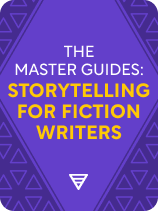

This article is an excerpt from the Shortform book guide to "The Master Guides: Storytelling for Fiction Writers" by Shortform. Shortform has the world's best summaries and analyses of books you should be reading.
Like this article? Sign up for a free trial here.
If you have a beginning, a middle, and an end, do you have a story? Is that all there is to story structure?
Story-writing experts generally agree that effective stories loosely follow the same pattern. This is called story structure, and most everyone knows that the basic story structure is beginning-middle-end. But, it’s not quite that simple.
Read more to get advice from Rob Biesenbach and Robert McKee on how to leverage the basic story structure for the greatest impact.
Basic Story Structure
In his book Unleash the Power of Storytelling, Rob Biesenbach asserts that people tend to think of a story as any narrative with a beginning, a middle, and an end, but he thinks this definition of a story is too simplistic. Certain things need to happen at each point in the structure to make a story; the basic story structure of beginning, middle, and end on its own is merely a series of events ordered from start to finish.
Biesenbach explains how you can map the essential elements of character, goal, and obstacles onto the familiar beginning-middle-end arc:
- At the beginning, set the scene, introduce your character, and set up an event that pushes your character into action to pursue their goal.
- In the middle, show the character working to overcome the obstacles that stand between them and their goal.
- At the end, give the character (and the audience) a resolution: Either the character reaches their goal or they don’t. (Without a resolution, your story will feel anticlimactic, frustrate your audience, and leave them confused about your message.)
Additionally, Robert McKee argues in his book Story that, to make a story continuously interesting, you must incrementally heighten the risk your protagonist is experiencing over the course of the story.
In life, we judge how valuable something is by how much we’re willing to risk or sacrifice for it, explains McKee. Thus, creating a protagonist who’s willing to risk everything they have is the most direct way to make an audience feel like the protagonist’s actions are important and meaningful.
If the protagonist continues to act in the same way, the audience knows to expect the same kinds of results, and they’ll get bored. Instead, force your protagonist to take progressively riskier and more extreme actions. That way, the audience knows that these actions will have new, interesting consequences, and they’ll be captivated.
Exercise: Analyze a Story
Pick a story you’re familiar with. Break down the story into its most basic structure. Summarize it in just three sentences: a beginning that sets up the plot, a middle with obstacles impeding the protagonist’s goal, and an ending that resolves that goal. (For example, in Monsters, Inc., Sulley’s job as a professional child-scarer is endangered when he accidentally lets a human child into the monsters’ world. He must hide the child from his coworkers and rescue her after she’s kidnapped by other monsters. Finally, he returns the child to her home.)

———End of Preview———
Like what you just read? Read the rest of the world's best book summary and analysis of Shortform's "The Master Guides: Storytelling for Fiction Writers" at Shortform.
Here's what you'll find in our full The Master Guides: Storytelling for Fiction Writers summary:
- How to capture and communicate emotional magic through fiction
- Advice from successful authors and storytelling experts
- The five steps of writing a story, from ideating to publishing






